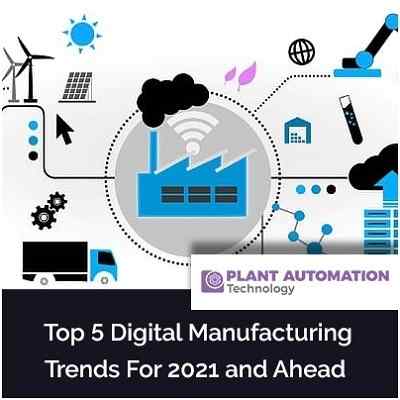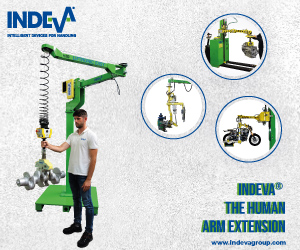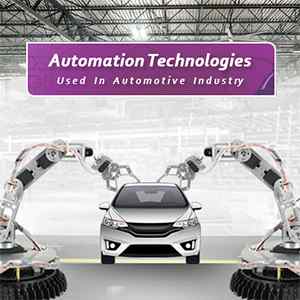Articles
Top 5 Digital Manufacturing Trends For 2021 and Ahead

The usage of computer systems to manufacturing products, supply chains, services, and processes is best defined as digital manufacturing. The digital manufacturing technologies link processes and systems across all production areas to make an integrated approach to manufacturing, right from design to production, and to the servicing of the final products. In short, digital manufacturing is when a company uses digital technologies to benefit its manufacturing operations. A factory that's connected, networked, and fully integrated can be produced by manufacturers, allowing them to use real-time data analytics to optimize the complete manufacturing process and realize productivity gains of 10 to more than 1,000%.
Digital manufacturing allows industrial manufacturers to -
- reduce inventory
- shorten time to market
- eliminate bottlenecks
- turn up quickly to meet customer requirements
- expand the number of products made.
- improve quality
Let's learn about the key digital manufacturing trends for 2021 and ahead.
A) Internet of Behavior (IoB)
Internet of Things (IoT) is no longer a part of some science fiction. The IoT technology that connects any electronic device to the Internet is very much underway and is already a reality in various fields. The collection of data and usage by IoT presents valuable insights into user's interests, behaviors, and preferences - something that has been aptly coined as the Internet of Behaviors.
The IoB is something we'll become gradually aware of in our routine lives and work. It merges the existing technologies that focus on the individual directly (e.g. location tracking, facial recognition, and big data) and connects the resultant data to associated behavioral events, such as device usage, or cash purchases. This data is used by organizations to influence human behavior. For instance, IoB might be leveraged by organizations through computer vision to observe whether employees are wearing masks or through thermal imaging to detect those with a fever. This would be helpful to monitor compliance with health protocols during the ongoing pandemic.
Similarly, your online movements as well as your real-life geographic position can be tracked by a single device, like a smartphone. Nowadays, brands know a lot more about you - your likes, interests, dislikes, and the way you purchase. E.g. Uber uses IoT data about traveler locations, drivers, and preferences to reimagine the end-user experience. It's predicted that more than half of the global population will be subject to at least one IoB program by year-end 2025. Though the IoB may be technically possible, there'll be wide societal and ethical debates about the various approaches employed to affect behavior.
B) Hyperautomation
Even though hyperautomation has been trending at an implacable pace for the past few years, the pandemic has increased demand with the unexpected requirement for everything to be "digital-first". The combination of multiple machine-learning (ML), packaged-software, and automation tools are incorporated together to deliver work. Another stage of intelligence is added to accessible automation strategies to connect humans into the process. Hyperautomation goes way beyond your typical automation technology. With the help of robotic process automation (RPA) the task completion is duplicated, while in hyperautomation, RPA would be just the first step into a world of AI technologies. It'll make use of the bot's intelligence by forming a union of different automation, all of which complement each other for a better outcome. Hyperautomation could potentially transform the future of industries, with technology and humans going hand in hand.
Hyperautomation helps automation of any routine repetitive tasks carried out by business users when AI tools combine with RPA. It even goes a mark up by automating through a combination of tools. Advancing robotic processes with intelligence create an intelligent digital workforce that can lower the human burden. These digital workers would be the support system of hyperautomation that would change the face of businesses. Tools that make hyperautomation possible are RPA, AI, iBPMS, and analytics.
C) Distributed Cloud
The cloud is gradually becoming more popular with manufacturers as it caters to their needs with its increased ease of use across numerous locations and the provided IT assistance. This enables manufacturers to spend more time focusing on everyone's goal, increasing their company's revenue. It's so well appreciated by people that they give it the title "Cloud manufacturing (CMfg)". Cloud is a network that allows you to store and manage files, data, and software to the Internet. It saves time and money besides being easily buildable, making it remarkably sustainable and functional.
CMfg - a process of using well-established manufacturing resources, such as Enterprise Resource Planning (ERP), through the cloud. The information can be viewed, updated, and applied at any time or place in this way. Cloud manufacturing was proposed to handle "big manufacturing" which implies it follows the entire manufacturing process from the designing stage to production to maintenance. It can take several forms such as virtualization, Internet of Things (IoT), and cloud computing. It also helps businesses unplug themselves so they can reach new heights faster than before. However, the idea of "unplugging" for few manufacturers makes it feel uneasy for them because if everybody in the organization could access data from anywhere, then there could be chances of sneaking a peek at sensitive information. While this could be an authentic concern, but cloud experts are certain that the cloud is just as safe as an on-premise program. The administrators still have whole control as to who can see what is in the cloud, so everyone can see everything that is permitted to see. Regarding the hacker's issue, several cloud service vendors provide 24-hour security to look out for any potential fraudulent code and security breaches. If you still feel it isn't safe, there are cloud-based ERP's like Acumatica that give you several deployment options including Saas, cloud, and on-premise.
It's anticipated that by 2025, most cloud service platforms will offer at least a few distributed cloud services that execute at the point of need. Thereafter, the distributed cloud can replace the private cloud and provides edge cloud and other new use cases for cloud computing.
D) Cybersecurity Mesh
A new level of cyber complexity to factories arises with the rise of digital technologies. But the question is, do the manufacturing companies have enough cybersecurity programs in place to prepare for these expanded risks? Looking at the current landscape, let us explore a few questions -
- To what extent are cyber threats affecting manufacturing today?
- How will the manufacturers address today's cybersecurity risks and how will they address the new risks?
- What level and type of risks exist in present-day factories?
- How can the manufacturers build cybersecurity controls into their smart factory initiatives?
Cybersecurity mesh is a distributed architectural approach to flexible, scalable, and reliable cybersecurity control. Several assets now exist outside the usual security perimeter. The cybersecurity mesh permits the security perimeter to be defined around the identity of a thing/person. It allows more of a responsive, modular security approach by distributing policy enforcement and centralizing policy orchestration. Cybersecurity allows anyone to access any digital asset security. It doesn't matter where the person or asset is located. It's anticipated that the cybersecurity mesh will support more than half of the digital access control request by 2025. As the operations continue to evolve anywhere, the cybersecurity mesh will become the most practical approach to make sure there's secure access to, and use of, cloud-located applications and distributed data from uncontrolled services.
E) AI Engineering
A strong artificial intelligence (AI) engineering strategy will assist the scalability, performance, reliability, and interpretability of AI models while delivering the full value of AI investments. AI can enhance or automate decisions and tasks performed by humans, making it essential for digital business transformation. With the help of AI, organizations can diminish labor costs, improve customer service or processes, and generate novel business models. AI engineering proposes a pathway, making AI a part of the mainstream DevOps process rather than a set of isolated and specialized projects. It brings jointly a range of disciplines to tame the AI hype while providing a clearer path to value when operationalizing the arrangement of multiple AI techniques. Because of the governance aspect of AI engineering, responsible AI is emerging to deal with transparency, fairness, trust, ethics, compliance, and interpretability issues.




